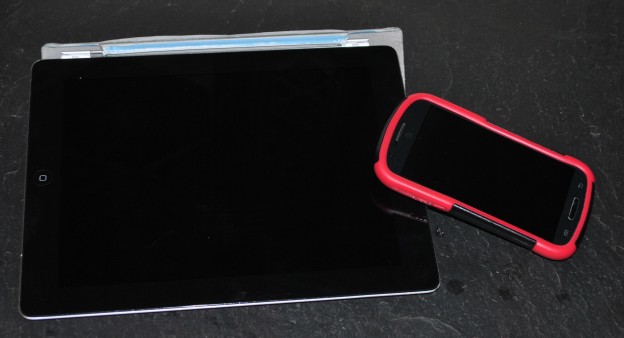If you’re a veterinarian, you’re in a bind.
How can you take great care of patients, educate staff, keep clients happy, grow your business, and still make money in this competitive market? Clients demand top quality pet care, but they want to save money. They also want their pet’s healthcare team to keep in close touch and to include them in planning. For their part animal health professionals want to provide care in a way that helps pets, satisfies clients, and pays the bills for the practice.
It’s tempting to think that buying the latest gadget will make your practice stand out and attract business. If you have a real need and know it will get used a lot, a specialized tool can give you bragging rights on your Facebook page. If not, that shiny new toy just takes up space.
Smart devices
But there’s a cheaper, easier option right in your pocket. Use the smart phones and tablets you already own to make money, save money, and provide better client service and pet healthcare. The beauty of this? You already know how to make them work. There’s no manual, no time lost to training.
Phones and tablets let you monitor your patients, fine tune care, and tap the commitment and skill of colleagues and clients to keep pets healthier at less cost. Good use of technology saves you time and lets you delegate conversations and client education to others.
Check out these 17 ways to use your smart devices:
1. Track the progress of pet care at home, such as weight management, by having clients text you updates.
2. Use an app or your own checklist to help clients evaluate pain in their pet.
3. Use your smart phone to monitor vitals and illness. Devices like the PetPace smart collar https://petpace.com/ allow you to track and analyze data and to receive alerts minute by minute.
4. Encourage your clients to keep up with treatment by texting non-judgmental messages every few days. Make sure you provide a way for them to write you back. Conversation is key to cooperation.
5. Improve in-house education by using free web conferencing tools, like Google+ Hangout or Big Blue Button.
6. Use a medical calculation app to figure dosages.
7. Use your tablet to take notes for your electronic medical record or to check information on VIN (Veterinary Information Network) right in the exam room.
8. Use your tablet or digital camera to take pictures of pets, so their families can keep up to date. This is especially helpful when patients are hospitalized. A picture of their loved one resting comfortably or wagging its tail reassures families that your staff is kind as well as competent. You can also add those photographs to the pet’s medical record.
9. Make your tablet a tool to educate clients. For example, show clients how to give sub- cutaneous fluids to their cat by showing them a video on YouTube. That way you can watch it together and answer any questions they may have. You can also introduce them to websites you think have the most accurate information. You may even have a PowerPoint presentation of your own to share with them.
10. Use a storage site like Drop Box to share photographs, radiographs, and any other files among your computers.
11. Use your tablet’s “virtual desktop” to share radiographs (x-rays) with your clients, so they understand what’s wrong and what you plan to do about it. Especially for visual learners, a picture is worth 1000 words.
12. Use sound effects apps to test a pet’s reactions and to help desensitize them from the things they are afraid of. You can also use one sound to muffle other sounds from the waiting room that can disturb a nervous pet. For example, you can make your practice more cat-friendly by putting them in a room with sounds that block the noise of barking dogs.
13. Use the timers on your equipment to track how you spend your time. You may be surprised. Think about one part of your day, like meetings or data entry. How long does that activity actually take?
14. Have clients video record behavior that occurs at home but not in the office. How many times have you had a client say, “My dog had an episode at the dog park that looked like a seizure, but who knows?” Or, “I swear, she was limping this morning.” Now you can see what they see. Make sure they know that sending you a photo doesn’t take the place of an exam.
15. A variation on #14 is to have clients record behavior problems and their surroundings. For example, if a client complains her cat urinates outside the box, have her take pictures where every box is located. She might even video what the cat does in the box, such as perching on the sides. You may be able to tell at a glance that the box is too enclosed or that the cat is avoiding that kind of litter. Solving problem behaviors keeps pets from being surrendered to shelters.
16. Ask clients to video themselves doing health-related tasks, such as drawing up insulin and injecting their pet. You might also ask them to send you before-and-after pictures of injury healing, photos that can go right into your electronic medical record.
17. Use your brain and your tablet’s for what they do best. Let your smart device’s capacity remember those obscure, once-in-a-lifetime medical possibilities. Tap your people skills and professional experience to make the most of client time. Learn what they know, what their concerns are, and how they feel about what your recommendations.
How it works
Here’s a real-life example of how using everyday devices can save you time and make your clients happier. I used to work at a big veterinary teaching hospital in New York City. New Yorkers are smart and tough. They don’t just take your word for things. They want proof, and they demand service. A liberal visiting policy isn’t always enough. Some want to sit by the cage or call their doctor every two hours for an update.
When you think about it, it makes sense. When our human family is laid up, we get to spend hours at their bedside, holding their hand and asking questions of the staff. We can see for ourselves whether their room is clean and if the nurses are compassionate. With pets it’s different. Most veterinary clinics don’t have room for extra people to pull up a chair by a cage and hang out. Veterinary nurses can’t stop to explain what they are doing or answer phone calls.
Then the doctors got new mobile phones. With cameras. Not only could they email clients, they could send pictures of pets doing better. Clients were delighted, and doctors enjoyed spreading good news. And with emails doctors could document their client contact without having to write a separate report.
And that’s how smart devices allow veterinary teams to provide better pet care and client service in less time with less hassle.
Caution
For all the good that smart devices do, it’s important to set limits to their use. Give yourself tech time out. Don’t check your phone at dinner. Tell clients what hours it’s OK to message you and stick to it. And have an office phone or other system so calls go to the veterinarian on duty and don’t give away your personal number.
If you have trouble staying away from your smart devices, use apps that block emails during certain hours. Can’t let go of work? Practice meditation to learn how to stay in the present moment.
What are your favorite ways of using tablets and smart phones around the office? Let us know! Maybe you’ll see your tip in a future post.



